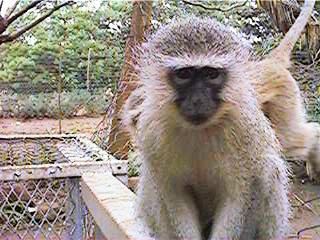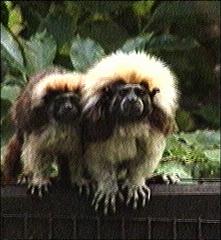

1. Complementary approaches: i) functional/behavioural studies; ii) (comparative) anatomical and physiological studies; iii) evolutionary studies, ethology.
2. Design features (Hockett 1960, Hockett and Altmann 1968, Coleman 2005).
a) Characteristics found in human and non-human communication:
 |
 |
| a) Vervet monkeys (above): distinct calls to signal the presence of different predators: snakes (surround and watch) vs. terrestrial predators (e.g. leopard: run up a tree) vs. avian predators (hide in the bushes). | b) Cotton-top tamarin: sounds (chirps and whistles) combined into calls, which may be further combined according rules of "lexical syntax". |
c) Bird
songs: structurally complex, and having at least two levels of
constituent
structure (phrases and notes). But variations in songs appear not to be
significant.
d) Dolphins: a variety of signals,
but no evidence (yet) of structural complexity.
e) Humpback whale: more complex, structured songs.
Changes from year to year are culturally transmitted. Unknown function.
Thus, it is clear that some degree of hierarchical structure (up to three structural levels), exhibiting duality of patterning, is far from unique to human language. However, recursive syntactic structures are not attested outside human language. More on this in lecture 4.
4. Comparative physiology
The larynx is lower in apes than monkeys, and lower in
humans
than apes. Bipedal locomotion
→
upright position → longer neck?
The lowering of the larynx, together with shortening of the jaw,
facilitates greater tongue mobility. Great apes have very
mobile
tongues, however. The human vocal apparatus is in several respects simpler
than that of the great apes. Gelada monkeys have a very rich inventory
of sounds (Richman 1976), combined into many rhythmic/melodic phrasal
patterns (Richman 1987).
References
Coleman, J. S. (2005) Design
features of language. In K. Brown,
ed. Encyclopedia of Language and
Linguistics, 2nd edition. Oxford: Elsevier. 471-5.
Hauser, M. D., N. Chomsky and W. Tecumseh Fitch (2002) The Faculty of Language: What Is It, Who Has It, and How Did It Evolve? Science 298 no. 5598, 1569-1579. http://dx.doi.org/10.1126/science.298.5598.1569
Hockett, C. F. and Altmann, S. (1969): see Demers, R. A. (1988)
Linguistics and animal communication. In
Newmeyer
(1988), 314-335.
Dingwall, W. O. (1988) The evolution of human communicative
behavior.
In Newmeyer (1988), 274-313.
Hockett, C. F. (1960) The origin of speech. Scientific American 293: 88 (Jan or Sept?) Reprinted in Human communication: language and its psychobiological bases: readings from Scientific American. San Francisco: W. H. Freeman and Co. 5-12.
Pepperberg, I. M. (1998) Talking with Alex: logic and speech in parrots. Scientific American presents: Exploring Intelligence. Vol. 9 (4). 60-65.
Richman, Bruce (1976)
Some vocal distinctive features used by gelada monkeys. Journal of the Acoustical Society of
America 60 (3), 718-724.
Richman, Bruce (1987)
Rhythm and melody in gelada vocal exchanges. Primates 28 (2), 199-223.
Yu, A. C.
and D. Margoliash (1996) Temporal hierarchical control of
singing in birds. Science 273, 1871-1875.